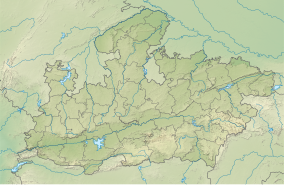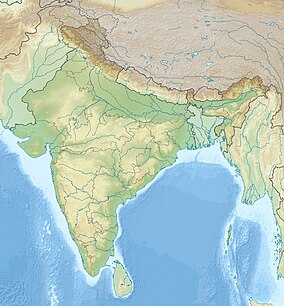Satpura Tiger Reserve
| Satpura Tiger Reserve | |
|---|---|
 Satpura Tiger Reserve | |
| Location | Narmadapuram, Madhya Pradesh, India |
| Nearest city | Pipariya |
| Coordinates | 22°29′42″N 78°13′52″E / 22.495°N 78.231°E |
| Area | 2,133 km2 (824 sq mi) |
| Established | 2000 (as Tiger Reserve) |
| Governing body | Ministry of Environment, Forest and Climate Change, Madhya Pradesh Forest Department |
| satpuratigerreserve.org | |
Satpura Tiger Reserve is a tiger reserve located in the Narmadapuram district of Madhya Pradesh in India. Its name is derived from the Satpura range. It covers total area of 2,133 km2 (824 sq mi), comprises of 524 km2 (202 sq mi) of Satpura National Park, 646 km2 (249 sq mi) of Bori Wildlife Sanctuary and Pachmarhi wildlife sanctuaries in the central Indian highland ecosystem.[1][2] It was declared as a tiger reserve in 2000.[3] It is rich in biodiversity with variety of plants and wild animals.[2]
History
[edit]Its name is derived from the Satpura Range. Satpura is a Sanskrit word, that means seven mountains (sapta – seven and pura – mountain). It was first explored by Captain James Forsyth of Bengal Lancers in 1862 while he was searching for Indian Freedom Fighter Tantya Tope.[4] It is one of the first declared Reserved Forest Area of India due to its ecological and commercial importance. It became a Tiger Reserve in the year 2000 and therefore it is also called Satpura Tiger Reserve (STR).[3]
Satpura Tiger Reserve, with inclusion of Pachmarhi & Bori Sanctuaries, Satpura National park covers 2133 km2 of Hoshangabad and Chhindwara Districts of Madhya Pradesh.[5]
Geography
[edit]Satpura Tiger Reserve is located in the Narmadapuram district of Madhya Pradesh in India. Its name is derived from the Satpura range. It covers total area of 2,133 km2 (824 sq mi) comprises 524 km2 (202 sq mi) area of Satpura National Park, 646 km2 (249 sq mi) of Bori Wildlife Sanctuary and Pachmarhi wildlife sanctuaries.[1][6] Satpura National Park was set up in 1981. The terrain of the national park is rugged and consists of sandstone peaks, narrow gorges, ravines and dense forests. The elevation ranges from 300 to 1,352 m (984 to 4,436 ft), with Dhoopgarh peak being 1,350 m (4,430 ft) and the almost level plains of Churna.[2] Tawa River flows through the park and Tawa reservoir has been built on this rivers.[7]
Climate
[edit]Satpura National Park experiences summer season from March to June and during this time temperature reaches 30 °C in morning hours and 40 °C in day-time. May and June months are of peak summer time with heat waves but in higher regions the temperature remains low. Monsoon arrives in July month and lasts till September or October months. The average rainfall in the region is about 1300–1700 mm. Winter season can be experienced from November to February during which temperature dips to 4 °C in morning hours around Pachmarhi Plateau and 15 °C in daytime. The lowest temperature is recorded as low as 1 degree in Pachmarhi. The winters are generally bright and cloudless with light showers in early November.[8]
Flora
[edit]
Satpura Tiger Reserve is a part of a Central Indian forest ecosystem and rich in biodiversity. Satpura Tiger Reserve has over 1300 species of plants including sal, teak, tendu, Phyllanthus emblica, mahua, bel, bamboo and medicinal plants.[2] Satpura Tiger Reserve has more than 62 trees species, 30 small tree species, 58 shrubs species, 32 climber species and almost 64 grass species. It also has important medicinal plants and rare endemic plants from the genus Psilotum, Cyathea, Osmunda, Lycopodium, and Lygodium. Saal is the most prominent flora of the National Park which is mainly found in the Pachmarhi plateau. The lower plains on the northern side of the park mainly consist of teak forest on basaltic traps. Many species like Melastoma malabathricum, Murraya paniculata, Holmskioldia senguinea, Blumea lanceolaria, and Sophora interrupta are found only in Satpura Tiger Reserve in Madhya Pradesh.[9][10]
Satpura Tiger Reserve has about 10% of the area which is classified as grasslands including natural blanks on Pachmarhi plateau, anthropogenic grassland due to relocation of villages and draw down areas of Tawa reservoir. These grasslands are named Neemghan, Madai, Keria, Dhain, and Geetkheda. In addition to these, some of the new grasslands have been created by relocation of 23 villages from the core area of the reserve. Mostly all the available grasslands are of anthropogenic origin and are subjected to agriculture and grazing. If these grasslands are not manipulated, they will be invaded by woody plants and eventually disappear. Protection and maintenance is done for these grasslands to support a size-able population of herbivores by the Satpura Tiger Reserve administration.[11]
Fauna
[edit]



Satpura national park, along with its surrounding buffer-zone area have a large and diversified population of wildlife. This forest area is unique in its ecosystem and has a long history of wildlife conservation. There are 50 species of mammals, 254 species of birds, 30 species of reptiles, and 50 species of butterflies that are found in the park.
Satpura hosts various species of fauna including Spotted deer, sambhar, gaur, Nilgai, Indian muntjac, four-horned antelope, chinkara, black buck, barasingha, mouse deer, tigers, leopards, wild boar, dholes, sloth bear, Porcupine, Pangolin, Indian Giant squirrel, Flying squirrels, Rhesus monkeys, langurs and Marsh crocodile.[1][12]
In 2015, 98 Barasingha were reintroduced to Satpura Tiger Reserve from Kanha Tiger Reserve. In 2024, there were 200 Barasingha in Satpura Tiger Reserve.[13]
Bird
[edit]
Satpura Tiger Reserve is home to many birds species including Hornbill, peafowl, Pigeon hawks, crested serpent eagle, owls, crow pheasants, Malabar whistling Thrush, Paradise Fly-catcher, Honey Buzzard, Malabar pied Hornbill.[1][14] There is presence of wide variety of flower species and moist conditions thus are ideal conditions for various butterfly species to flourish like Oakleaf, Black Rajah, Great Eggfly.[15]
See also
[edit]References
[edit]- ^ a b c d "Jungle Book of Churna: Safari zone in Satpura Tiger Reserve". New Indian Express. 15 October 2022. Retrieved 4 February 2025.
- ^ a b c d "Satpura National Park". protectedplanet.net. Archived from the original on 3 June 2012. Retrieved 25 September 2011.
- ^ a b "The thrill of a night safari in Satpura". Live Mint. 12 June 2022. Retrieved 2 February 2025.
- ^ "Satpura National Park History". satpura-national-park.com. Retrieved 8 August 2018.
- ^ "Satpura Tiger Reserve". www.satpuratigerreserve.mp.gov.in. Retrieved 8 August 2018.
- ^ "The wild cast of Bori". Deccan Herald. 23 April 2023. Retrieved 4 February 2023.
- ^ "Tawa reservoir Ramsar wetland - TAWA RESERVOIR RAMSAR WETLAND". ETV Bharat (in Hindi). 16 August 2024. Retrieved 2 February 2025.
- ^ "Satpura National Park Weather Climate". satpura-national-park.com. Retrieved 8 August 2018.
- ^ Negi, S. S. (2002). Handbook of National Parks, Wildlife Sanctuaries and Biosphere Reserves in India. Indus Publishing Company. p. 67. ISBN 9788173871283.
- ^ "The enduring charm of Satpura Tiger Reserve in Madhya Pradesh". Indian Express. 3 March 2019. Retrieved 2 February 2025.
- ^ "Village Relocation and Employment Generation Protecting Tigers in Satpura". Indian Masterminds. 27 July 2023. Retrieved 2 February 2025.
- ^ "Into the Wild: The Jungles of Satpura National Park, Madhya Pradesh". Archived from the original on 13 December 2021. Retrieved 2 September 2019.
- ^ "Madhya Pradesh's barasingha and gaur populations soar thanks to conservation efforts". New Indian Express. 25 February 2024. Retrieved 2 February 2025.
- ^ "Satpura Tiger Reserve". www.satpuratigerreserve.mp.gov.in. Retrieved 17 September 2018.
- ^ www.satpura-national-park.com. "Satpura National Park Mammals Checklist, Satpura Mammals Checklist, Satpura National Park Wildlife, Animals in Satpura National Park, Satpuda Mammals, Satpura National Park Wild Animals". satpura-national-park.com. Retrieved 17 September 2018.
External links
[edit] Satpura Tiger Reserve travel guide from Wikivoyage
Satpura Tiger Reserve travel guide from Wikivoyage- forest.mponline.gov.in



